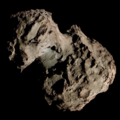 A mosaic of C/1999 H1 (Lee) taken on 9 December 1999 | |
| Discovery [1] | |
|---|---|
| Discovered by | Steven Lee |
| Discovery site | Mudgee, Australia |
| Discovery date | 16 April 1999 |
| Orbital characteristics [2] | |
| Epoch | 17 August 1999 (JD 2451407.5) |
| Observation arc | 267 days |
| Number of observations | 1,019 |
| Aphelion | ~5,500 AU |
| Perihelion | 0.708 AU |
| Semi-major axis | ~2,800 AU |
| Eccentricity | 0.99974 |
| Orbital period | ~146,000 years |
| Inclination | 149.25° |
| 162.65° | |
| Argument of periapsis | 40.702° |
| Mean anomaly | 0.0002° |
| Last perihelion | 11 July 1999 |
| TJupiter | –0.896 |
| Earth MOID | 0.151 AU |
| Jupiter MOID | 0.257 AU |
| Physical characteristics [2] | |
| Comet total magnitude (M1) | 9.4 |
| Comet nuclear magnitude (M2) | 13.1 |
| 6.0 (1999 apparition) [3] | |
C/1999 H1 (Lee) is a non-periodic comet observed between April 1999 and January 2000. It is the only comet discovered by Australian astronomer, Steven Lee. Lee found the comet visually during a star party near Mudgee, New South Wales on 16 April 1999. [4] He estimated the comet had an apparent magnitude of 9. [1]

